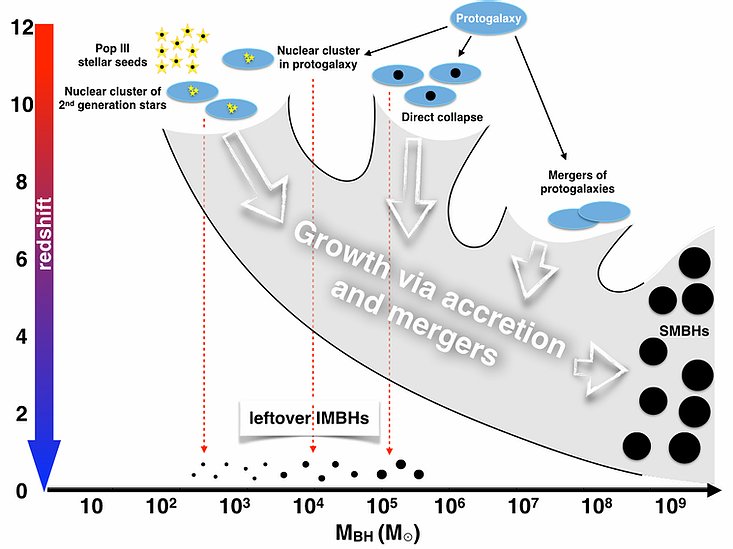TITANs Science
Formation of SMBHs
How do Supermassive Black Holes form?
 We will study the formation of supermassive black holes under realistic conditions, taking into account gas-dynamical processes, chemistry and cooling, as well as stellar dynamical processes to obtain realistic models, and including the derivation of gravitational wave signatures from the formation process. These investigations will be complemented with accurate measurements of the black hole mass function .
We will study the formation of supermassive black holes under realistic conditions, taking into account gas-dynamical processes, chemistry and cooling, as well as stellar dynamical processes to obtain realistic models, and including the derivation of gravitational wave signatures from the formation process. These investigations will be complemented with accurate measurements of the black hole mass function .
Growth of SMBHs
How does black hole growth take place?
 We will probe supermassive black hole growth - and its impact on the host galaxy, i.e. 'feedback' - across cosmic history, making use of large surveys like eROSITA and SDSS-V, plus individual detailed studies using ALMA and the VLT. We aim to better understand systematics in different SMBH measurement techniques, and refine indirect SMBH estimators, via our program to apply multiple measurement techniques - including molecular and ionized gas, stellar dynamics, and reverberation mapping - to each galaxy in a well chosen sample. Additionaly, numerical simulations will be used to better understand the effect of black hole accretion on the evolution of the host galaxy.
We will probe supermassive black hole growth - and its impact on the host galaxy, i.e. 'feedback' - across cosmic history, making use of large surveys like eROSITA and SDSS-V, plus individual detailed studies using ALMA and the VLT. We aim to better understand systematics in different SMBH measurement techniques, and refine indirect SMBH estimators, via our program to apply multiple measurement techniques - including molecular and ionized gas, stellar dynamics, and reverberation mapping - to each galaxy in a well chosen sample. Additionaly, numerical simulations will be used to better understand the effect of black hole accretion on the evolution of the host galaxy.
SMBHs: inner structure
Accretion inflows, outflow (jets), and more black hole shadows
 We will explore, in a large sample of nearby galaxies, black hole accretion inflows and outflows (jets) in the immediate surroundings of the black hole (10s to 1000s Schwarzschild radii; via the EHT, GMVA. LBA, and EVN), the accretion disk structure and instabilities (100 to 1000s Schwarzschild radii; via reverberation mapping like techniques in double peakers), and on galaxy scales (10pc to kpc scales; via VLT/MUSE and ALMA) in samples of nearby AGN. We continue to participate in ongoing EHT observations and imaging of M87, SgrA*, and several powerful AGNs already observed with the EHT. Technical improvements since 2017 now allow the EHT to image the jet base (less than 100 gravitational radii) in several dozens of AGNs. Within the EHT Collaboration, we lead the project to identify the definitive sample of AGNs for all EHT and next-generation-EHT (ngEHT) observations in the coming decades. We expect to obtain the first EHT observations of the first of these over 2021-22. We are also active particpants in the ngEHT project, a first step towards imaging the black hole shadow in tens to hundreds of AGNs. These studies will be complemented through numerical simulations probing instabilities in the inner accretion disk and the onset and feedback of the accretion flow on sub-parsec scales and GRHMD simulations to predict the results of EHT imaging of the accretion inflow in a large number of AGNs.
We will explore, in a large sample of nearby galaxies, black hole accretion inflows and outflows (jets) in the immediate surroundings of the black hole (10s to 1000s Schwarzschild radii; via the EHT, GMVA. LBA, and EVN), the accretion disk structure and instabilities (100 to 1000s Schwarzschild radii; via reverberation mapping like techniques in double peakers), and on galaxy scales (10pc to kpc scales; via VLT/MUSE and ALMA) in samples of nearby AGN. We continue to participate in ongoing EHT observations and imaging of M87, SgrA*, and several powerful AGNs already observed with the EHT. Technical improvements since 2017 now allow the EHT to image the jet base (less than 100 gravitational radii) in several dozens of AGNs. Within the EHT Collaboration, we lead the project to identify the definitive sample of AGNs for all EHT and next-generation-EHT (ngEHT) observations in the coming decades. We expect to obtain the first EHT observations of the first of these over 2021-22. We are also active particpants in the ngEHT project, a first step towards imaging the black hole shadow in tens to hundreds of AGNs. These studies will be complemented through numerical simulations probing instabilities in the inner accretion disk and the onset and feedback of the accretion flow on sub-parsec scales and GRHMD simulations to predict the results of EHT imaging of the accretion inflow in a large number of AGNs.